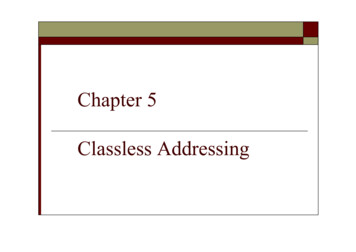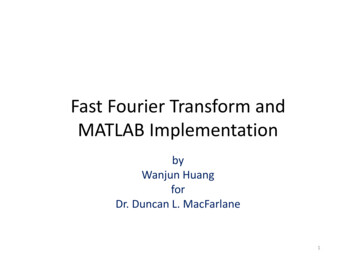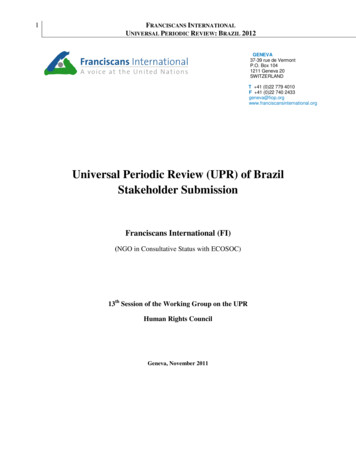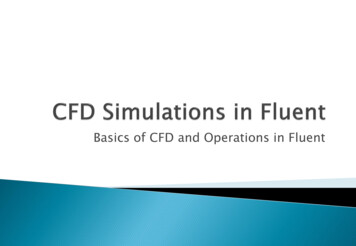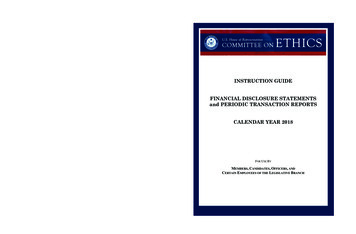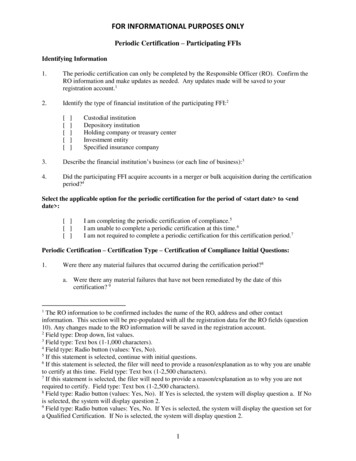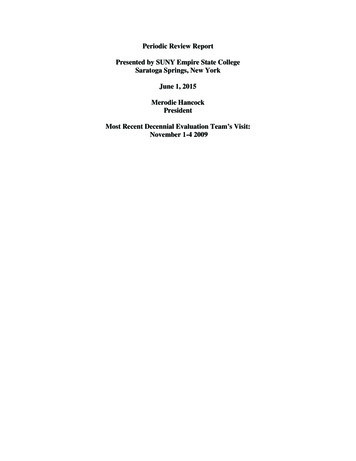
Transcription
Periodic Review ReportPresented by SUNY Empire State CollegeSaratoga Springs, New YorkJune 1, 2015Merodie HancockPresidentMost Recent Decennial Evaluation Team’s Visit:November 1-4 2009
Periodic Review ReportContentsExecutive SummaryCertification Statement: Compliance with MSCHE Requirements of Affiliation and RelatedEntities Policy (For SUNY State-Operated Institutions)Certification Statement: Compliance with Federal Title IV Requirements (for SUNY StateOperated Institutions)Institutional Response to Self-StudyMajor Challenges and Opportunities for the InstitutionEnrollment and Finance Trends and ProjectionsAssessment of Institutional Effectiveness and Student LearningLinked Institutional Planning and Budgeting ProcessesAppendicesA. Vision 2015 Strategic PlanB. Academic Plan 2011C. Information Technology Services 2015 Interim Report to the CollegeD. Learning Contract RubricE. Annual Credits by Center and Program 2010-11 to 2013-14F. Annual Student Headcount by Center, Program and Unit 2010-11 to 2013-14G. Four Year Headcount Trend 2010-11 to 2013-14H. IPEDS Financial Survey F1B 2011-12I. IPEDS Financial Survey F1B 2012-13J. IPEDS Financial Survey F1B 2013-14K. Revenue Projections 2013-14L. Revenue Projections 2014-2015M. Revenue Projections 2015-16N. Institutional Learning Outcomes Assessment: Comprehensive Review of Methodologies andResults 2006-2012O. 2014 Academic Assessment PlanP. 2014 Academic Assessment Plan Supplement
Executive SummaryOverview of the InstitutionEmpire State College was established in 1971 as a distinctive statewide State University of NewYork (SUNY) institution focused on innovative teaching and learning, where college facultymentors guide learners through design of individualized degree programs. Accredited by theMiddle States Commission on Higher Education, the college serves mostly working adultspursuing associate, bachelor’s, and master’s degrees onsite at 35 locations in New York Stateand abroad, as well as online.The Board of Trustees of the State University of New York is the college’s governing body. Likeall SUNY institutions, the college has a College Council appointed by the governor and chargedwith advising the college’s president and administration. The New York State EducationDepartment has final authority on the approval and registration of the college’s degree programs.The college has a coordinating center in Saratoga Springs where administrative offices arehoused. Also located in Saratoga Springs are the Center for Distance Learning, the School forGraduate Studies, the School of Nursing and the Office of International Programs. Regionalcenters are located in Buffalo, Rochester, Syracuse, Albany, Hartsdale, New York City and OldWestbury; each of these centers has two or more satellite units within its region. The HarryVan Arsdale Jr. Center for Labor Studies is located in Manhattan.The undergraduate degree programs are currently structured around 12 areas of study. Studentswork closely with a faculty mentor and, using area of study guidelines and overall degreerequirements, plan their degree based on transfer credits (transcript and prior learning credits)and Empire State College courses to meet the goals of their chosen degree area. The areas ofstudy guidelines are similar to competency statements, around which students choose coursesand individualized learning contracts to be used within their program to meet the degreerequirements. In this way, students are able to customize their studies to meet their personal andprofessional goals, as well as ensure that their degrees are current for their chosen field.The minimum residency requirement for students is 31 credits for a 124-credit bachelor’s degreeand 24 credits for a 64-credit associate degree. The balance of credits may come from transfer(transcripts or prior learning). Students may use different standardized exams, militaryoccupations or training, or community and corporate training and certifications evaluated by theAmerican Council on Education (ACE), National College Credit Recommendation Services(NCCRS), other regionally accredited institutions and by Empire State College. In addition,students can be assessed for learning not previously evaluated by one of the acceptedorganizations though an individualized portfolio process. Empire State College has engaged inPrior Learning Assessment (PLA) since its beginnings and is considered one of the nation’sleaders in the field.Today, the college has 19,534 students spanning associate, bachelor’s and master’s degreeprograms; 18,131 of these students are undergraduates. The college’s students represent a diverse
community of learners and tend to be of non-traditional age with work and family commitmentsthat won’t accommodate a conventional college experience.Most of the college’s students are between 25 and 49 years old, with a median age of 36, and arein the prime of their working lives. They are employed as professionals, managers or skilledworkers. They may be anyone from the CEO of a company to a working performing artist to aveteran transitioning to civilian life. Of this demographic, 59.7 percent study part time and 40.3percent study full time. Most students are New York state residents with every county in thestate represented; those in large metropolitan areas, suburbs, small towns and rural communities.The college also enrolls students from every state in the U.S. and from 50 other countries. Thosewho are not residents of the state of New York generally enroll through the college’s onlineprograms. There is a higher percentage of minorities in the college’s student pool than in theoverall US population and the racial distribution approximates that of the state of New Yorkwith Asians and Hispanics being the only underrepresented portions (Asians: 2.3 percent ratherthan 8.2 percent; Hispanics 10.7 percent rather than 18.4 percent) of the NY state populace (USCensus Bureau, 2015). Overall, 64 percent of students received some form of financial aid in theyears 2012-2013 and 2013-2014. Slightly less than 10 percent of the student body are active dutymilitary and veteran students.The largest percentage, 41 percent, of the college’s students, study at one of the college’s 35locations across the state of New York. Approximately 40 percent of the college’s undergraduatestudents, state residents and nonresidents, enroll in online programs. Another 19 percent enrollthrough other centers and programs, such as the college’s Harry Van Arsdale Jr. Center forLabor Studies or the Office of International Programs. Every ESC student receives personal,one-to-one guidance from faculty mentors or advisers, whether enrolling in a regional locationor studying at a distance.Approach to Preparation of Periodic Review ReportEarly preparations for the PRR began in spring 2010, when a summary of self-study actionitems, the team’s single recommendation and the team’s suggestions were posted on the collegewebsite as a link to the Vision 2015 strategic plan. The summary was shared and discussed withgovernance and administrative groups. Implementation of self-study action items beganimmediately. The Academic Planning Task Force was appointed in 2010. During the 2010-2011academic year, the task force consulted widely in the college, drafted a plan, gained approvalfrom the governance body and president and published the final academic plan in 2011.Thefunction of strategic planning was strengthened with the hiring of a director of strategic planningin 2010. In 2011, a guide to strategic planning was published and the director offered training ingroups and with individuals as each office and academic center developed objectives, actionplans and measures aligned with the college’s 2010-2015 strategic plan.A new president came to the college in summer 2013. Toward the end of her first year, sheoutlined an approach to restructuring the college, known as ESC 2.0, that was designed toassure that human resources, facilities and technology were organized to strengthen service tostudents in a distributed environment. Comments were invited from the college community toinform further development of the plan. In fall 2014, three teams were appointed to facilitate
collegewide discussions called “prototyping conversations” to review core features of thecollege’s academic approach: educational planning, mentoring and academic program review.The discussions, which yielded significant and broadly based input, were robust. Participantsfrom across the college, including faculty, staff, professional employees, staff, administrators,students and alumni, appreciated the opportunity to join these sustained conversations andcontributed thoughtfully and creatively.The prototyping conversations were summarized in a report published in February 2015. Thereport presented various models for improving and diversifying the college’s approaches tothe three core areas that were the focus of the conversations. In the coming year, the proposedmodels will be explored through pilot projects. The prototyping conversations identifiedpotential paths for reinvigorating the college’s distinctive academic approaches. They alsoprovided a rich source of information for the PRR.The provost provided updates on the PRR in his reports to the college senate during the currentacademic year. A draft report was posted to the college community on the internal website inMay with a general invitation for comment. Requests for comment also went directly to thecollege senate and the president’s council. The final version of the report incorporates thefeedback received.Summary of Major Institutional Changes Relevant to Accreditation StandardsThe college had made major investments in support of strategic planning and assessment toenhance these functions and align more fully with MSCHE standards. The college also has plansfor changes that will require substantive change approval from MSCHE. Two proposals fordoctoral programs have been developed: Doctor of Management (DM) in organizationalleadership and Doctor of Education (Ed.D) in educational leadership. These practitioner-orienteddegrees will be the college’s first degrees at the doctoral, so the college will seek substantivechange approval as the proposals move through required SUNY and New York State EducationDepartment reviews.The college will open a new building in Rochester in early 2016. Another building is planned forSuffolk County on Long Island and will go out to bid in August 2015. These new buildings willreplace two of our leased facilities with state-of-the-art facilities designed to serve adult learnerswith on-site instruction and services and support for videoconferencing and other technologymediated instruction. The college is considering new additional locations in Jamaica, Queens,and in Nassau County on Long Island. Leases in Cheektowaga/Buffalo and Staten Island arenearing their end and these locations may be moved. With over 35 locations throughout NewYork, we have substantive change requests at least once every two years and often morefrequently. The procedure for requesting substantive change approval is a regular part of ourprocesses for adding or moving locations and we will make requests at the appropriate time foreach of these moves or additions.The college is developing a bachelor’s degree program in information technology that follows alimited direct assessment model. The program would include three competency-based courses.We understand that this type of competency-based program does not currently require MSCHE
approval, but we also recognize that regulations in this area are in flux and we monitor themcarefully to maintain compliance.Highlights of the ReportThe single recommendation from the 2009 evaluation team, which was directed to the SUNYsystem as well as to the college, called for a more equitable allocation of resources to EmpireState College. The college is pleased to report that significant progress in this area has beenachieved through collaboration with the SUNY system senior administration. The team’s othersresponses to the self-study were in the form of suggestions. As the suggestions were closelyaligned with action items presented in the college’s self-study report, the college chose to includethem in this report.The college went into a period of declining enrollment and revenue shortly after the lastdecennial review. The enrollment and financial analyses in this report describe how these issueswere addressed and, to a large extent, reversed.The report describes a deeply engaged faculty, staff and administration on the brink oftransformative change. A new administrative structure will strengthen academic programs,student services, and enrollment management. Three broadly participative college conversations,on the core college features of mentoring and advising, educational planning and academicprogram have generated a set of new models that will be explored in the coming year. A furtherconversation on student success and retention is ongoing at the time of this report and it willproduce recommendations in fall 2015. For the first time in its history, the college will own twobuildings outside its administrative headquarters in Saratoga Springs; previously all sites outsideSaratoga Springs were leased. These buildings, in Rochester and Suffolk County, Long Island,will offer state of the art facilities designed for 21st-century adult students.The college completed a strategic plan in 2010 and expanded support for planning through thehiring of a director of strategic planning and the implementation of a planning and assessmentmanagement system. The college plan was the starting point for related academic, facilities andinformation technology plans. In the area of student learning outcomes assessment, acomprehensive review of existing methodologies and results was completed in 2013. Anacademic assessment plan building on this analysis was completed in 2014. Numerousimprovements to the processes for student learning outcomes assessment have been introducedand an academic assessment plan implementation committee is examining further changes.The assessment of institutional effectiveness has been less centrally coordinated than assessmentof student learning. The planning and assessment management system has assisted deans ofacademic centers and directors of functional offices and services to record and track theirobjectives and action plans. The college sent two president’s council level administrators to aMSCHE workshop on assessing institutional effectiveness and planning for a more coordinatedcollegewide approach has begun.With the implementation of a new administrative structure over the next two years and newapproaches to mentoring and advising, educational planning, academic program development
and review and student success and retention unfolding in the same time frame, the next selfstudy, set to begin in 2017, will offer an excellent opportunity to reflect on and assess theseinstitutional changes.Writing and Editing TeamSandra Barkevich, instructional support assistant, Office of Academic Affairs, and student,master of arts in learning and educational technologyRick Barthelmas, assistant vice president for administrationKristina Delbridge, director of financial aidBrian Goodale, director of academic developmentMarjorie Lavin, vice provost for academic services, chairJohn Lawless, mentor, associate professor and faculty associate for outcomes assessment,Central New York CenterRonnie Mather, interim dean, Center for Distance LearningSeana Logsdon, director of academic support, Genesee Valley CenterDawn Riley, director of strategic planningPaul Tucci, vice president for administration
Institutional Response to Self-StudyIn preparation for the decennial review for reaccreditation in 2009-2010, the college conducted abroad participatory self-study over a two-year period beginning in fall, 2007. The final self-studyreport was published in August 2009, and the evaluation team visit took place in November2009. In March 2010 the commission reaffirmed the college’s accreditation for a full 10-yearterm and commended the institution for the quality of the self-study process and report. Nointerim reports were required.The evaluation team made one recommendation and also offered 15 collegial suggestions. Theself-study report identified 30 action items and the evaluation team suggestions were closelyaligned with the action items coming out of the institutional self-study. This section summarizesthe institution’s response to the single recommendation from the team and addresses the actionitems arising from its self-study and team suggestions. The self-study grouped the 14accreditation standards into six groups with a set of action items associated with each group ofstandards. The summary of institutional responses to the action items is organized in the sameway.Mission, Planning and Resources (Standards 1-3)Team RecommendationThe Team recommends that SUNY continue to explore a more equitable way to allocateresources to Empire State College that acknowledges its unique mission.ResponseIn FY 2010-2011 the vice president for administration began working with a newly formedSUNY Resource Allocation Team charged with the development of a new resource allocationmethodology. There were several subcommittees established as part of the process focusing onenrollment, research, peer institutions and geographic cost differential, to name a few. Thecollege’s vice president for administration served on the SUNY Research AllocationSubcommittee that was charged with suggestions for a new model for allocating state supportthat rewards campus research outcomes, encourages campus engagement in research, andcontributes to the goals and objectives of SUNY’s strategic plan. Over a period of severalmonths the various subcommittees convened and discussed several tracks in developing a newallocation methodology. A draft model was presented to senior SUNY administration that wouldhave resulted in a more equitable allocation for the institution, but the proposed model was notadopted given political considerations of adding to or reducing specific campus allocations. Thecollege’s senior administrators continue to work with SUNY to achieve greater equity and someprogress has been made in the past year.In the fall of 2011 the SUNY Board of Trustees passed a resolution approving a five year tuitionplan for the University. The resolution was the culmination of intense negotiations betweenSUNY, the Governor and the State Legislature. The agreed upon “rational tuition plan” wascalled for modest but predictable tuition increases each year that promoted planning for both
students and campuses. This resolution also came with the promise of “maintenance of effort” ofState support which was ultimately interpreted by the state as keeping constant the direct statesupport for the SUNY system in terms of absolute dollars appropriated over the five year period.Empire State College’s share of the direct state support over the first four years of the planremained almost flat ranging from 8.7 million to 9 million while campus share appropriationof tuition revenues increased from 42.7 million to approximately 61 million. The increasecampus share in spending authority was driven by two components: the first componentconsistent with the tuition rate increases, and the other component recognizing a larger portion ofcampus enrollments previously not recognized in the funding formula by SUNY. The lattercomponent is an important one in that it more closely recognizes the college’s full enrollmentrather than a historical funded enrollment that seldom increased as enrollments grew at thecollege. Discussions continue with SUNY and it is expected the final year of the rational tuitionplan will bring Empire State College even closer to having funding to cover all enrollments.Overall, the college was able to grow its operating budget from both the tuition rate increasesand growth in recognized enrollment.During the same time period the college was successful in increasing its capital appropriationfrom SUNY and/or the state, starting with an effort to update the college’s facilities master plan.After several months of delay the college, working with State University Construction Fund, wasable complete a land acquisition and architectural design changes necessary to begin the formalbid process for a new learning center in the Rochester area. The funding for the project was madeavailable and ground was broken on the Rochester center in the summer of 2014. The collegewas also successful in getting approval to exercise a lease option to purchase a buildingpreviously leased from the Empire State College Foundation, allowing for approximately 1.1million in rental expense savings. Most recently the college was successful in identifying landfor the second planned learning center location in Long Island. These projects will set the stagefor the reconfiguration associated with ESC 2.0, the realignment of administrative and academicservices and the future plans for a student services center.The college has also been successful in obtaining several grants from SUNY and privatefoundations. The college plans to continue its efforts to explore new ways to enhance resources,including capital funding, grant opportunities, enrollment recognition and the possibility of newonline rates in support of our online programs.Self-Study Action ItemEnhance institutional capacity in planning and assessment of institutional effectiveness toensure more coherence and relevance for all of the college’s annual and long-termplanning and to more effectively measure and record the effectiveness of all aspects ofthe college’s work.Related Team SuggestionThe team suggests that ESC take an integrated approach to strategic planning acrossimportant functions such as budget, enrollment, academics, staffing and workload,facilities and technology.Response
In the last five years, the college has produced a strategic plan, an academic plan, and anacademic assessment plan. A facilities master plan and a strategic information technology planwere developed in the same period, and the technology plan is currently under revision. Tosupport the implementation and tracking of operational plans, the college hired a director ofstrategic planning to formulate a planning and assessment process, starting with operational unitsof the coordinating center and, later, extending to academic centers across the state. To managethe collegewide process, the college adopted an assessment management system, WEAVE, tosupport and advance outcomes articulation, alignment of operational and academic units to thekey goals and strategies in Vision and MSCHE Characteristics of Excellence and annualplanning, assessment and reflection to “close the loop” in advance of new planning.While the college has conducted assessment of student learning outcomes in academic programsand general education courses, the processes for assessing effectiveness in non-academic areashas been more dispersed and less coordinated with assessment responsibilities delegated todirectors of functional offices and services. Empire State College is in the process of building aformal institutional effectiveness plan to guide and document “an organized, sustainedassessment process covering all major administrative units, student support services andacademic programs.”Self-Study Action ItemIncrease systematic consultation and information-sharing about budget developmentbeyond President’s Council and PPBC.ResponseThe Office of Administration provides budget narratives by division to the entire collegecommunity by annually publishing this information on the college’s internal website. Thispractice was adopted in 2010. In addition to budget report presentations outlined in the originalself-study we also provide quarterly budget and facilities updates to the College Council,periodic budget updates to local chapter union leadership and their members, as well as budgetand facilities updates at the various college-wide town hall meetings held during the year. ThePresident and vice president of administration also provided a college-wide budget update andState of the College address at our annual All College event held in Saratoga Springs in March2015.Self-Study Action ItemDevelop improved metrics for assessing budget performance and the effect of newinvestments.ResponseWhile the College has metrics on the cost per credit by locations of academic offering and byfaculty resources, we continue to develop measures and metrics as a way to assess the allocationof finite resources. We have migrated away from a prior resourcing model that focused on totalenrollment credits to one that focuses more on direct instructional credit in an effort to eliminateredundant funding of instructional resources and prioritize new or expanded areas of funding. Anew resourcing model has defined the number of credits of instruction expected of faculty andthe number of enrolled mentees with whom each faculty should be engaged. The transition to
this direct instruction/mentoring model has been incrementally implemented to comply withcollective bargaining agreement terms. A new academic administrative structure organizedaround academic areas will allow us to monitor our progress while allocating resourcesefficiently and where most.Self-Study Action ItemCreate a participatory process for developing a strategic plan.ResponseA new president, Alan Davis, came to the college in 2008, about halfway through the 2006-2010strategic plan. In May 2009, six months before the evaluation team visit, the president developeda process for broad consultation in the development of the college’s next strategic plan. Theprocess was endorsed by the college senate at the June 2009 governance retreat. The consultationprocess was initiated in September 2009, between the publication of the self-study report inAugust and the evaluation team visit in November.Consultation on the new strategic plan began in fall 2009, with open forums held in regionsthroughout the state for college faculty, staff and students. Updates on the process were made ateach meeting of the College Senate, College Council, Empire State College Foundation Board,and the Alumni Federation Board of Governors. A draft plan was presented to the CollegeSenate, College Council, President’s Council and the State University of New York SystemAdministration in January and February 2010. The president presented the plan in his report atthe plenary session of annual All College Conference in March 2010 and the final version,Vision 2015, was published in May 2010, and submitted to the SUNY Chancellor. (SeeAppendix A)After President Merodie Hancock came to the college in 2013, she decided to extend the Vision2015 strategic plan through 2016. She asked the director of strategic planning to lead arepresentative college group in identifying and analyzing models for strategic planning and toengage the president’s cabinet in the evaluation of these models. The rubric developed toevaluate these plans includes the kind of consultation built into each planning model.While the development of a new strategic plan has been deferred for a year, the collegecommunity is extensively engaged in conversations about core features of the college that willhave implications for a new strategic plan. Three prototyping teams presented models developedfrom collegewide conversations on mentoring, educational planning and academic programreview. Another team is currently gathering ideas about enhancing support for student success.ESC 2.0 is an initiative to assure optimal use of our resources through an administrativerestructuring that will differentiate academic program management and enrollment managementand provide greater coordination of distributed student services.These conversations have been supported with technology in a variety of ways. In addition, thepresident has provided collegewide updates and invited comment through “Town Hall meetings”held via videoconference and webcasting three times since September 2014. A similarcombination of face to face and technology-mediated consultation will inform the developmentof the college’s next strategic plan.
Self-Study Action ItemEnhance institutional capacity in planning and assessment of institutional effectiveness toensure more coherence and relevance for all the college’s annual and long-termplanning and to more effectively measure and record the effectiveness of all aspects ofthe college’s work.ResponseSpecific to non-academic areas, most of our progress towards institutional effectiveness has beenbasic and broad, but effective. In 2010-2011 many of the non-academic or functional areasjoined the rest of the college in the implementation of a new strategic planning tool, WEAVE.With the creation of Vision 2015 strategic planning started to expand its presence into otherareas and WEAVE served as a tool for reporting and measuring our progress in this area. Thecollege started taking the steps necessary to break beyond operational silos and having enhancedconversation about planning, assessment and capacity building. WEAVE allowed the variousfunctional areas to set goals in concert with the Vision 2015 strategic plan and annually reviewand assess the status of those goals. For many departments this was an approach to planning thathad not been done before and allowed non-functional areas to make a measurable contribution tothe planning process of the college. Many of the goals for the non-academic areas centeredaround enhancing service to both students and college employees and also involved planning fornew revenues to support the college. The next action steps will incorporate planning for therealignment associated with ESC 2.0, the college’s planned administrative restructuri
Presented by SUNY Empire State College . Saratoga Springs, New York . June 1, 2015 . Van Arsdale Jr. Center for Labor Studies is located in Manhattan. The undergraduate degree programs are currently structured around 12 areas of study. . (DM) in organizational leadership and Doctor of Education (Ed.D) in educational leadership. These .
